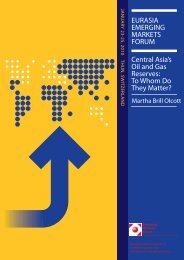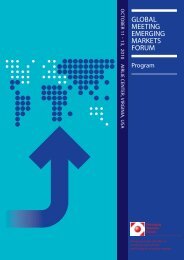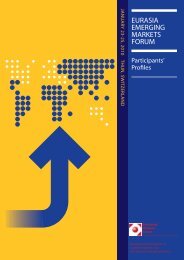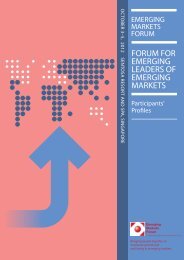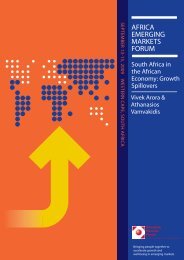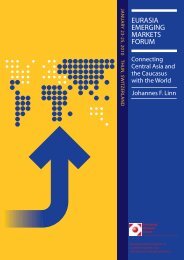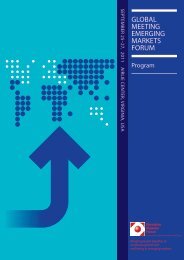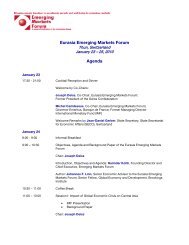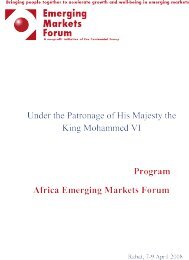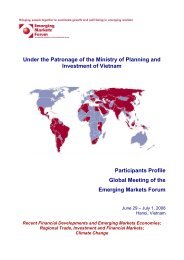THE CENTENNIAL RESILIENCE INDEX: EXPANDING ITS COVERAGE AND TESTING ITS PREDICTIVE POWERBox 1<strong>The</strong> <strong>Centennial</strong> <strong>Resilience</strong> <strong>Index</strong> <strong>and</strong> the Rationale for Each Element<strong>The</strong> <strong>Centennial</strong> <strong>Resilience</strong> <strong>Index</strong> provides a measure of the capacity of an economy to cope with <strong>and</strong> bounce back after havingbeen hit by an external shock.<strong>The</strong> index groups its 56 input component variables into ten element, as specified in Appendix 1. <strong>The</strong> rationale for each of itselements <strong>and</strong> components is briefly described below:Fiscal Policy SoundnessThis represents the space policy makers have to adopt fiscal measures. <strong>Its</strong> components are the stock of public debt in relationto GDP as well as the rate (<strong>and</strong> direction) of change of this variable as a measure of the overall deficit. A higher debt ratio or overalldeficit decreases the space.Monetary Policy Soundness<strong>The</strong> greater the credibility the central bank has built up – for example, by such actions as controlling inflation — the moreroom the central bank has to ease monetary policy in a slowdown, thereby supporting activity in the economy. <strong>Its</strong> components arethe difference between domestic inflation <strong>and</strong> G-7 inflation, whether an inflation targeting framework is in place (as it is typicallyassociated with increased credibility), <strong>and</strong> a measure of the unpredictability of inflation, estimated by its historical st<strong>and</strong>ard deviation.Government Effectiveness<strong>The</strong> stronger the capacity of government officials to react <strong>and</strong> design policies, the better <strong>and</strong> faster will be the implementationof these policies <strong>and</strong> thus the response of the economy. <strong>The</strong> greater the capacity of the government to follow through with its plans,the more likely the private sector will respond positively to stimulus measures, <strong>and</strong> thus the higher the country’s resilience. <strong>Its</strong>components are the quality of the bureaucracy <strong>and</strong> the ability to consistently implement forward-looking policies.Overall GovernanceGood governance is generally seen as a necessary underpinning to an efficient economy, with reliable <strong>and</strong> independentinstitutions, adherence to the rule of law (confidence in contracts, property rights, etc.), transparency, limits to corruption, pressfreedom, required bank <strong>and</strong> credit ratings, accounting disclosure, shareholder rights, <strong>and</strong> availability of both private- <strong>and</strong> publicsectorst<strong>and</strong>ardized data. <strong>Its</strong> components are indices of corporate governance, legal system, <strong>and</strong> policy transparency, <strong>and</strong> are takenfrom the <strong>Index</strong> of Financial Development <strong>and</strong> Strength developed by <strong>Centennial</strong> Group International (see methodology).Bank SoundnessA sounder financial system with less risk of default, a strong capital base, well-provisioned assets, non-volatile income sources,<strong>and</strong> high profitability is less likely to amplify an external shock <strong>and</strong> thus makes the economy more resilient. Although this elementrepresents predominantly banks, it also includes some non-bank financial institutions, <strong>and</strong> therefore measures the broader financialsector. <strong>Its</strong> components—all derived from the IMF’s Financial Soundness Indicators Compilation Guide — are indices asset quality,capital base, <strong>and</strong> income risk, <strong>and</strong> are also taken from the <strong>Index</strong> of Financial Development <strong>and</strong> Strength developed by <strong>Centennial</strong>Group International.Export Diversity<strong>The</strong> more diversified the export base, the more resilient the economy is likely to be. <strong>Its</strong> components measure export diversity bydestination <strong>and</strong> product.Export Independence<strong>The</strong> greater the dependence on exports, the less resilient to an external shock an economy is likely to be. <strong>Its</strong> component is theratio of exports to GDP.External Robustness<strong>The</strong> stronger the external sector, the more resilient an economy is likely to be. <strong>Its</strong> components are the current account balanceas a proportion of GDP, the ratio of international reserves to short term debt, the stock of reserves in terms of months of imports, <strong>and</strong>a classification of the exchange rate regime.Private Debt<strong>The</strong> private debt element includes components measuring both external debt <strong>and</strong> domestic debt. Much domestic debt consistsof bank credit to the private sector, <strong>and</strong> its excessive growth leads to destabilizing asset bubbles. Regarding external debt, thefaster the expansion of externally financed credit to the private sector, the less resilient an economy is likely to be to a sudden stopin capital flows. (Externally financed credit should not be seen as financial deepening, which involves credit growth mainly financedby domestic financial savings.) <strong>Its</strong> components are the ratio of private credit by deposit money banks to GDP, the change over threeyears of this ratio, the change in the ratio of loans from foreign banks to private credit by domestic banks, the ratio of claims on the
Box 1<strong>The</strong> <strong>Centennial</strong> <strong>Resilience</strong> <strong>Index</strong> <strong>and</strong> the Rationale for Each Elementcountry’s residents by foreign banks to GDP, <strong>and</strong> the change in this ratio. It would have been helpful <strong>and</strong> appropriate to includecurrency composition of private sector debt, but the relevant data was not available.International Reserves <strong>and</strong> Net International InvestmentAt least up to some limit, the higher the reserve holdings the stronger the self-insurance they offer; in addition, a high stock ofreserves provides policy makers with room for maneuver <strong>and</strong> confidence to adopt expansionary policies in a downturn. Thus, a highstock of reserves constitutes a buffer against external shocks. While it would appear that the higher the stock of reserves, the betteroff the country is, there are important costs in such an approach. Moreover, a recent IMF study shows that the self-insurance aspecttapers off after a certain level of reserves. A positive international investment position also indicates room for maneuver for both theprivate <strong>and</strong> public sectors. <strong>The</strong> components of this element of the resilience index are the ratio of international reserves to GDP <strong>and</strong>the ratio of the net international investment position to GDP.resilience <strong>and</strong> their capacity to counter further negativeforces emanating from the industrial countries?An equally important objective is to explore whatthe <strong>Resilience</strong> <strong>Index</strong> may be signaling about thecapacity of certain EMCs <strong>and</strong> regions to respond tocontinued sluggishness in the U.S. economy <strong>and</strong>recession in Europe<strong>The</strong> continued effects of the Global FinancialCrisis <strong>and</strong> of the Euro-zone crisis on theEMCs 11In contrast to the sudden shock caused by theglobal financial crisis of 2007/08 manifest in the seizingup of global credit markets, recent difficulties inthe advanced countries reflect the protracted <strong>and</strong> stillongoing effects of that crisis — including, most importantly,the de-leveraging necessitated by the earliercredit excesses <strong>and</strong> asset price bubbles. Moreover,the protracted nature of this adjustment has been accompaniedby high volatility, arising from large swingsin market perceptions about the adequacy, or lackthereof, of the measures adopted by the advancedcountries to address their difficulties. As was the case11 <strong>The</strong> rationale for reviewing again developments that followed the onsetof the global financial crisis is three-fold: to update the previous paper, to setthe stage for using the revised index (see below) to test its capacity to see—before their crises—the worsening situation in the peripheral Euro-zonecountries, <strong>and</strong> to predict which countries/regions now look at risk.with the impact of the global financial crisis of 2008,the effects of these more recent developments onthe EMCs also vary significantly among countries <strong>and</strong>regions.While the transmission of developments in theadvanced countries to the EMCs is coming througha number of channels — including on expectations<strong>and</strong> confidence — we focus on the financial <strong>and</strong> realactivity channels.1. <strong>The</strong> financial channelThis section examines the impact of globalshocks on the EMCs as a result of their exposure tofinancial flows. <strong>The</strong> financial channel impacts EMCsthrough portfolio allocation, foreign direct investment(FDI), <strong>and</strong> cross-border lending. Additional shockscould materialize from the slowdown in Europe, thecontinued sluggish recovery in the U.S., <strong>and</strong>, potentially,further decreased growth rates in China, India,<strong>and</strong> Brazil. A major feature of linkages between advancedeconomies <strong>and</strong> EMCs over the recent periodhas been the repeated risk-on/risk-off behavior ofcapital flows, alternating between inflow surges duringoptimistic periods <strong>and</strong> sudden stops or reversals



